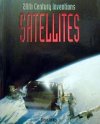A Satellite of Your Own
Hot Sites and Cool Books
Information about student CubeSat projects can be found at www.mae.cornell.edu/cubesat/ (Cornell University), eng.usna.navy.mil/~bruninga/cubesat.html (U.S. Naval Academy),
www.space.t.u-tokyo.ac.jp/cubesat/index-e.html (University of Tokyo), and www.cubesat.com/(Cuesta College).
To learn about a CubeSat construction kit, go to www.cubesatkit.com/ (Pumpkin).
The KatySat program has a Web site at www.katysat.org/(KatySat).
Information about satellite communication can be found at ctd.grc.nasa.gov/rleonard/(NASA).
Ramsayer, Kate. 2004. Reach for the sky. Science News for Kids (Dec. 1). Available at http://www.sciencenewsforkids.org/articles/20041201/Feature1.asp.
Sohn, Emily. 2003. Dreams of floating in space. Science News for Kids (Sept. 10). Available at http://www.sciencenewsforkids.org/articles/20030910/Feature1.asp.
Books recommended by SearchIt!Science:
 |
Satellites— Steve ParkerPublished by Raintree Steck-Vaughn, 1997.
Although we seldom see satellites, they are an important part of our world. They do everything from helping us communicate with each other to helping forecast the weather. Learn how satellites are deployed, how they stay up, and the many things that they do for us. |
 |
Escape from Earth— Peter AckroydPublished by DK Publishing, 2003.
“I would not like to go to sleep,” said U.S. Vice President Lyndon Johnson, “beneath a communist moon.” The space race and the Cold War kick off this book, which traces humanity’s journey into space, from Sputnik to space shuttles to the Hubble space telescope. Meet Soviet hero Yuri Gagarin, the first human to travel in space, and other astronauts. Find out about explorations of Venus, Mars, and beyond; read a detailed history of the Apollo program; and learn about Mir and other space stations. Filled with color photographs, diagrams, and illustrations, and always within the context of history, this comprehensive volume ends with a look at the future of space exploration. |
Power Words
satellite
1. An object that moves around a larger object in outer space. The Moon is a satellite of the Earth. 2. An object that is made by people and sent into outer space to move around the Earth or another object such as a planet or the Sun. Satellites carry special equipment and are used for research, communications, weather information, and navigation.
A satellite used for telecommunications receives information, such as television signals, from a station on the ground. The satellite sends these signals back to other parts of the Earth.
 |
Copyright © 2002, 2003 Houghton-Mifflin Company. All rights reserved. Used with permission.